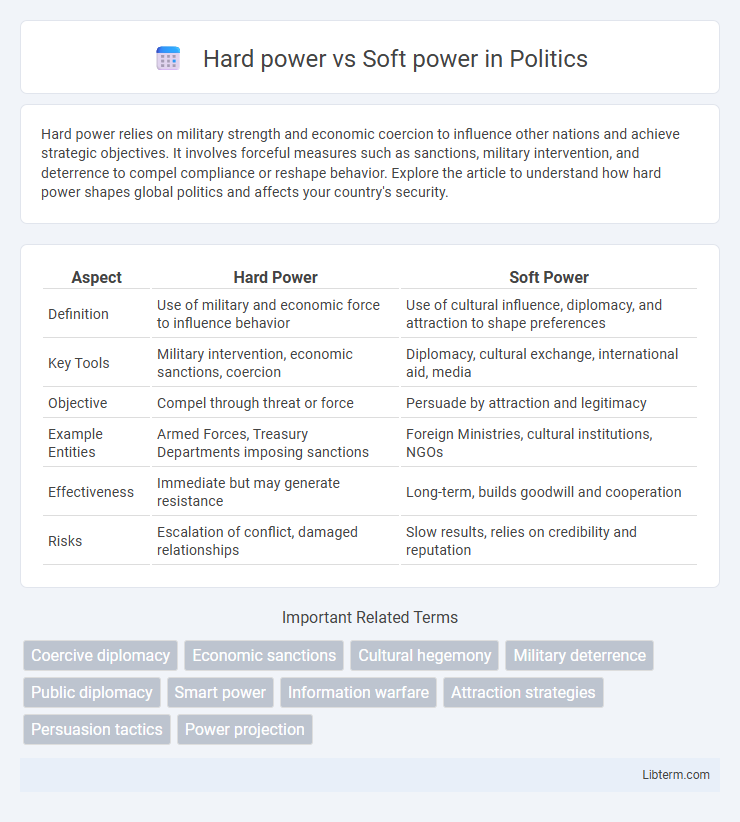Hard power relies on military strength and economic coercion to influence other nations and achieve strategic objectives. It involves forceful measures such as sanctions, military intervention, and deterrence to compel compliance or reshape behavior. Explore the article to understand how hard power shapes global politics and affects your country's security.
Table of Comparison
| Aspect | Hard Power | Soft Power |
|---|---|---|
| Definition | Use of military and economic force to influence behavior | Use of cultural influence, diplomacy, and attraction to shape preferences |
| Key Tools | Military intervention, economic sanctions, coercion | Diplomacy, cultural exchange, international aid, media |
| Objective | Compel through threat or force | Persuade by attraction and legitimacy |
| Example Entities | Armed Forces, Treasury Departments imposing sanctions | Foreign Ministries, cultural institutions, NGOs |
| Effectiveness | Immediate but may generate resistance | Long-term, builds goodwill and cooperation |
| Risks | Escalation of conflict, damaged relationships | Slow results, relies on credibility and reputation |
Understanding Hard Power and Soft Power
Hard power involves the use of military force or economic sanctions to influence the behavior of other states, relying on coercion or payment to achieve foreign policy goals. Soft power, in contrast, is the ability to shape the preferences of others through appeal and attraction, leveraging cultural influence, diplomacy, and values to foster cooperation. Effective international relations often depend on a strategic balance of hard power capabilities and soft power resources to maximize influence without conflict.
Historical Evolution of Power Dynamics
The historical evolution of power dynamics reveals a shift from hard power, characterized by military force and economic sanctions, towards the increasing importance of soft power, which relies on cultural influence, diplomacy, and ideological appeal. Ancient empires such as Rome and Persia dominated through hard power strategies, while the 20th century marked the rise of soft power with institutions like the United Nations and global media shaping international relations. Contemporary geopolitics blends both approaches, reflecting the complexity of maintaining influence in a globalized world.
Key Components of Hard Power
Hard power relies primarily on military strength and economic coercion to influence other nations' behavior. Key components include military capabilities such as armed forces, defense technology, and nuclear arsenals, alongside economic tools like sanctions, trade restrictions, and financial leverage. Control over strategic resources and the ability to enforce policies through force or economic pressure define the effectiveness of hard power in international relations.
Key Elements of Soft Power
Soft power relies on cultural influence, political values, and foreign policies that are seen as legitimate and attractive to other nations. Key elements include diplomacy, cultural exchange programs, international aid, and the promotion of human rights, which shape global perceptions and foster cooperation. Effective soft power enhances a country's ability to achieve foreign policy goals without coercion or economic incentives.
Major Examples of Hard Power in International Relations
Major examples of hard power in international relations include military interventions, economic sanctions, and defense alliances. The United States' military campaigns in Iraq and Afghanistan demonstrate hard power through direct force projection. Economic sanctions imposed by the United Nations on North Korea exemplify coercive diplomacy aimed at influencing state behavior through financial pressure.
Notable Instances of Soft Power in Global Politics
Notable instances of soft power in global politics include the United States' cultural diplomacy through Hollywood, which promotes American values worldwide, and Japan's use of technological innovation and pop culture to enhance its international image. China's Belt and Road Initiative combines economic investment with cultural exchanges to expand influence across Asia, Africa, and Europe. Additionally, South Korea's global popularity of K-pop and Korean dramas has significantly boosted its soft power, fostering favorable perceptions and diplomatic goodwill.
Comparative Analysis: Hard Power vs. Soft Power
Hard power, characterized by military force and economic sanctions, compels behavior through coercion and tangible pressure, while soft power leverages cultural influence, diplomacy, and values to shape preferences and build long-term alliances. The effectiveness of hard power is often immediate and visible, yet can provoke resistance, whereas soft power fosters voluntary cooperation but requires time to manifest impact. Combining hard and soft power in a strategic balance, known as smart power, enhances a nation's ability to achieve foreign policy goals through both influence and deterrence.
The Impact of Hard and Soft Power on Global Influence
Hard power, characterized by military force and economic sanctions, exerts immediate and tangible influence on global affairs through coercion and deterrence. Soft power, derived from cultural appeal, diplomacy, and values promotion, fosters long-term influence by shaping preferences and building international alliances. The interplay of hard and soft power enhances a nation's overall strategic position, with successful global influence often relying on a balanced and context-specific application of both.
Advantages and Limitations of Each Power Approach
Hard power leverages military force and economic pressure to achieve political objectives, offering clear and immediate influence but often generating resistance or long-term instability. Soft power relies on cultural appeal, diplomacy, and values to shape preferences and build alliances, providing sustainable influence with less backlash but requiring time and mutual trust to be effective. Both approaches face limitations: hard power risks escalation and loss of legitimacy, while soft power may struggle against immediate crises or against actors indifferent to cultural persuasion.
Future Trends in Power Strategies
Future trends in power strategies emphasize a hybrid approach combining hard power, such as military strength and economic sanctions, with soft power tools like cultural influence and diplomatic engagement. Technological advancements, including cyber capabilities and artificial intelligence, are reshaping how states project both coercive and persuasive power globally. Nations increasingly invest in comprehensive power frameworks that integrate traditional hard power with emerging soft power mechanisms to address complex geopolitical challenges.
Hard power Infographic

 libterm.com
libterm.com